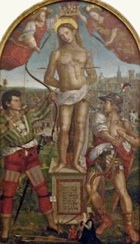

The Pinacoteca Comunale was established in 1868 in Palazzo Bufalini. It moved to the ex-church of San Filippo Neri in 1876 and to Palazzo Vitelli alla Cannoniera in 1912.
Early Art
Maestà (early 14th century)
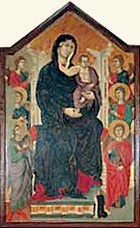
Scenes from the Life of St Antony Abbot (late 14th century)
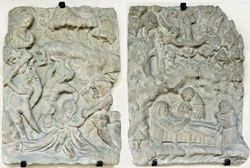
These two reliefs in the lower loggia, which came from Sant’ Antonio Abate, depict:
-
✴St Antony Abbot tempted by demons, as God the Father looks down from Heaven; and
-
✴the death of St Antony Abbot and the ascent of his soul, carried by angels.
Madonna and Child (ca. 1400)
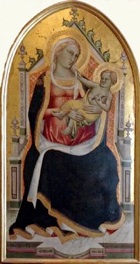
Panel from a Triptych (1412)
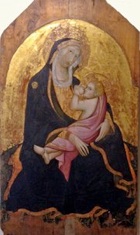
-
✴The right-hand panel of St Floridus, which is attributed to the latter artist, is in the Museo del Duomo.
-
✴The third panel, which depicted St Amantius, has been lost.
Reliquary of St Andrew (1414-20)
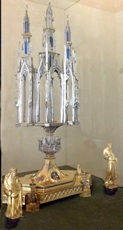
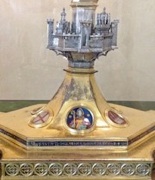
According to tradition, Pope Celestine II (died 1144) gave a relic of St Andrew to his sister, Angelina, who was a nun at Santa Maria in Trastevere (see the page on Santa Chiara delle Murate). It probably passed to the Commune in 1411, when the nuns moved to a new site inside the city walls. The Commune commissioned this reliquary for it from Lorenzo Ghiberti in 1414. The relic in its new reliquary was first exposed in San Francesco in 1420. The reliquary was apparently thrown down a well to save it from French troops in 1789. It was in restoration in Florence in 1966, at the time of the flood there, and suffered further damage. It was subsequently transferred to the gallery and was restored in 2012.
The reliquary, which is usually thought to have been a workshop production, is made of solid silver on a gilt base. The glass in the upper part that enclosed the relic has beed destroyed. The central part of the structure is an idealised model of Città di Castello. An inscription below it names the priors who commissioned the reliquary and gives the date of its completion, 1420. The base contains translucent enamel depictions of bishop saints (including St Floridus) and the arms of the city. Some scholars doubt that gilded bronze statues of SS Francis and Andrew that are displayed with it actually formed part of the original.
Ognissanti Triptych (1417 )
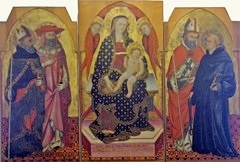
This triptych, which is dated by inscription, was documented in the Chiesa di Ognissanti in 1868, at which time it had already been dismembered. It was transferred to the civic collection before 1899. The panels depict:
-
✴the Madonna and Child enthroned with two seraphim (in the central panel);
-
✴SS Augustine and Jerome (in the left panel); and
-
✴SS Floridus and Leonard (in the right panel).
San Bartolomeo Triptych (ca. 1430)
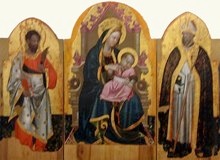
This triptych from San Bartolomeo is attributed to Antonio Alberti da Ferrara. It was moved to the Vitelli Chapel in San Francesco in 1921 and to the gallery in 1931. It depicts the Madonna and Child enthroned in the central panel, flanked by SS Bartholomew and Benedict.
Madonna and Child (1446)
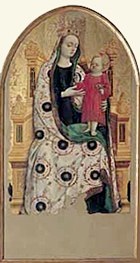
Madonna and Child with angels (15th century)
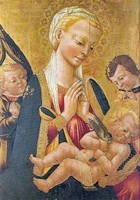
Christ and Signs of the Passion (15th century)

Coronation of the Virgin (15th century)
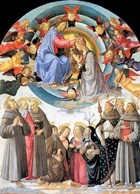
It is based on the altarpiece (1486) of the Coronation of the Virgin that Ghirlandaio painted for the Observant Franciscans of the Convento di San Girolamo, Narni, but is not of comparable quality.
Works by Luca Signorelli
The gallery contains the following works that are by or attributed to Luca Signorelli.
Fresco fragments (1474)
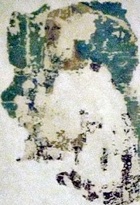
The fresco was apparently in good condition until the earthquake of 1789. It was attributed to Luca Signorelli in 1832 (if not before), and this is generally accepted. If the attribution is indeed correct, it is among Signorelli’s earliest works. It suffered further damage when it was detached in 1935. (Judging from this illustration in Wikimedia, it has suffered yet further deterioration since).
Martyrdom of St Sebastian (ca. 1498)
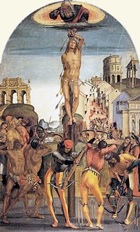
THOMAS DE BROZZIS ET FRANCESCA UXOR
FIERI FECIT MCCCCLXXXXVIII
(Tommaso Brozzi and his wife, Francesca [Cesari]
had this work made: 1498)
The will of Tommaso Brozzi records that he had indeed established this chapel in 1498, and the surviving frame bears his arms.
The circumstantial evidence provided by the frame suggests that Tommaso Brozzi commissioned Signorelli’s altarpiece in ca. 1498. It was probably Signorelli’s last work in Città di Castello before he left for Orvieto. It remained in situ until at least 1856, and was transferred to the gallery in 1867.
The frame of the Signorelli altarpiece had an almost identical pendant on the opposite side of the church that later housed the altarpiece (1502-3) of the Crucifixion with Saints (the Mond Crucifixion) by Raphael. Raphael clearly had the opportunity to study Signorelli’s altarpiece as he worked on his own commission in the church. Indeed, a sketch (ca. 1500) by Raphael of one of Signorelli’s figures (the archer to the right who faces away from the viewer) survives in the Ashmolean Museum, Oxford.
Gonfalon (ca. 1500)
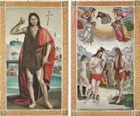
-
✴One face depicts St John the Baptist and three scenes from his life:
-
•St John in the desert;
-
•the trial before Herod; and
-
•the feast of Herod.
-
✴The other face depicts the Baptism of Christ.
The work is generally though to be from the workshop of Luca Signorelli. Following its restoration in 2011, Tom Henry (2012, referenced in the page on the artist) judged that the first side was indeed probably a workshop production, but that the second side was probably largely the work of Signorelli himself.
Santa Cecilia Altarpiece (1516-7)
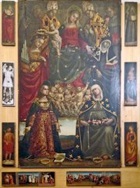
The frame no longer survives, but the surviving original components are displayed together:
-
✴The composition of the central panel is in three tiers:
-
•In the upper part, the enthroned Madonna and Child are flanked by:
-
-SS Francis and Bonaventura, on the left; and
-
-SS Louis of Toulouse and Antony of Padua, on the right.
-
•SS Cecilia (whom Christ crowns) and Clare stand to the sides.
-
•SS Catherine of Alexandria and Elizabeth of Hungary kneel below.
-
All of the saints except SS Francis, Antony of Padua and Clare are richly dressed.
-
✴The surviving pilaster panels depict:
-
•St Bernardino of Siena;
-
•St Jerome;
-
•John the Baptist;
-
•St Lucy; and
-
•St Margaret of Antioch.
-
The sixth pilaster panel, which depicted St Michael, was stolen in 1986, and is replaced in the gallery by a monochrome copy.
-
✴The surviving panels that derived from the originally single predella depict the martyrdoms of:
-
•St Cecilia;
-
•St Valerian (her fiancé); and
-
•St Tibertius (St Valerian’s brother).
Raphael
Of the many works that Raphael executed in Città di Castello early in his career, only one remains in the city.
Gonfalone della Santissima Trinità (ca. 1503)
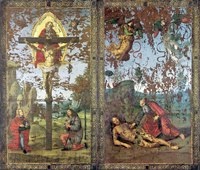
This two-sided processional banner was probably commissioned by the Confraternita della Trinità, which met in the Chiesa della Santissima Trinità. It was first documented there in 1627, with an attribution to Raphael, and again a year later, when it was deemed to be too damaged to be used in processions. The two sides were subsequently separated and were used as altarpieces at the sides of the high altar of the church until 1855, when they suffered the first of a series of attempted restorations. The most recent of these, in 1952 and 1983, were of very high standard, but much of the damage could not be reversed. The panels passed to the Commune in 1860.
The panels depict:
-
✴Holy Trinity (God the Father, the Crucified Christ and a dove representing the Holy Spirit) with SS Sebastian and Roch; and
-
✴the creation of Eve from Adam’s rib, with two angels.
Each retains its original gilded border.
A preparatory sketch for the figure of God the Father in the panel on the right survives in the Ashmolean Museum, Oxford. The same sheet contains a sketch of a detail of the altarpiece (1498) of the Martyrdom of St Sebastian by Luca Signorelli in San Domenico, Città di Castello, to which Raphael’s Mond Crucifixion (1503 - see below) formed a pendant. Raphael presumably executed these sketches while he was in San Domenico in order to plan his design for the altarpiece, which suggests that the banner was also painted in ca. 1503.
Works by Francesco Tifernate
Annunciation (ca. 1505)
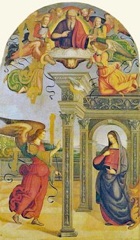
An inscription on the now-lost predella referred to the donor, Giovanni Magalotti and gave the date, 1504. However, the document commissioning the altarpiece makes it clear that this inscription related only to the altar.
The contract for the altarpiece was signed in 1505 between:
-
✴Ludovica, the widow of Giovanni Magalotti, who had obviously died in the previous year; and
-
✴Francesco Tifernate, under the guarantee of his father, Battista di Florido, which suggests that Francesco was still a minor.
Ludovica specified that the dimensions of the altarpiece should be similar to those of Raphael’s altarpiece for the Gavari chapel in the same church: i.e. Raphael’s Crucifixion with Saints (ca. 1503).
Although the main panel of the altarpiece survives in the gallery, the documented predella no longer survives.
Ognissanti Altarpiece (ca. 1504 )
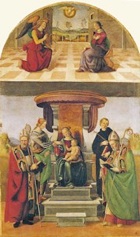
-
✴the Annunciation, in the upper lunette; and
-
✴the Madonna and Child enthroned with: St Catherine of Alexandria (to whom the baby Jesus gives a ring), St Nicholas of Tolentino and two bishop saints.
The work draws on contemporary precedents by Raphael:
-
✴the upper part is based on one of the predella panels of his Oddi Altarpiece form Perugia;
-
✴the lower part is based on the main panel of the Colonna Altarpiece from Perugia; and
-
✴the figure of St Catherine in the lower part is based on the Virgin in his Marriage of the Virgin (1504) in San Francesco, Città di Castello.
Agostino Tofanelli, the Director of the Musei Capitolini, Rome attempted to confiscate the altarpiece 1813 (at which time it was attributed to a follower of Perugino), but the local authorities were able to resist because it was still in use in the church. (The relevant research by Christina Galassi is referenced in the page on the artist). The panel was still in situ in 1897 but transferred to the civic collection in 1912.
Works by Andrea della Robbia
The loggias on the ground and first floor of the gallery contains the following works that are by or attributed to Andrea della Robbia or his workshop.
Works from San Giovanni Battista (early 16th century)
The works in the Pinacoteca include a number of glazed terracotta reliefs from San Giovanni Battista that were transferred here in 1872.
Assumption of the Virgin
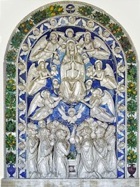
Adoration of the Shepherds
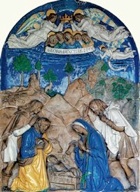
Madonna and Child with angels and putti
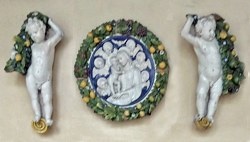
The tondo relief in the lower loggia was documented in the convent in 1728.
Annunciation (early 16th century)
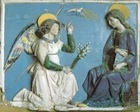
Works by Raffaellino del Colle
The gallery contains a number of works by or attributed to Raffaellino del Colle.
Annunciation (ca. 1528)
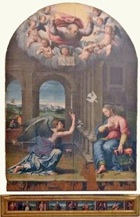
The main panel was transferred to the gallery in 1912. Three predella panels also here, each of which depicts three saints, probably belonged to this altarpiece.
Deposition (ca. 1552)
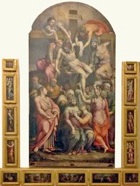
Agostino Tofanelli, the Director of the Musei Capitolini, Rome attempted to confiscate the altarpiece 1813, but (as Cristina Galassi - referenced below -has shown) the local authorities were able to resist because it was still in use in the church. (The relevant research by Christina Galassi is referenced in the page on the artist). The panel was transferred to the gallery in 1912.
A number of small panels that are also here (six depicting angels holding the instruments of the Passion and five depicting scenes from the Passion) were recently recognised as having come from this altarpiece, and are now exhibited beside it.
Annunciation (ca. 1559)
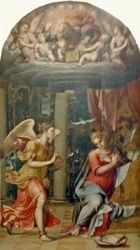
Assumption of the Virgin (1560)

Presentation of the Virgin (ca. 1560)
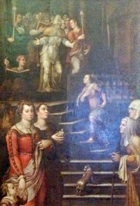
Works by Nicolò Circignani
Panels from San Francesco
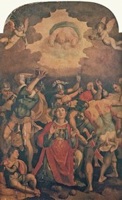
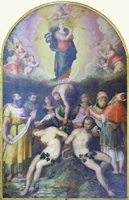
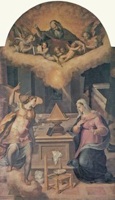
Martyrdom of St Stephen (1570) Immaculate Virgin (1573) Annunciation (1570)
From 1st altar on right Documented (1728) From 3rd altar on right
in right transept
These three panels from San Francesco are all signed by Nicolò Circignani, il Pomarancio and dated by inscription. They were all documented in the civic collection in 1878.
The composition of the panel of the Immaculate Conception is derived from that of a panel (1540) by Giorgio Vasari from SS Apostoli, Florence, which is now in the Ashmolean Museum, Oxford. The Immaculate Virgin is depicted triumphing over original sin. Adam and Eve are bound to the Tree of Knowledge below and flanked by figures from the Old Testament.
Other Works
Martyrdom of St Sebastian (1524)
-
✴the commissioner, Battista di Giacomo Corti (who is pictures kneeling with his wife and son at the bottom of the composition;
-
✴the artist, Giacomo di Milano; and
-
✴the date 1524.
This is the only known work by Giacomo di Milano, although he was documented in 1525-6 at Santa Maria di Monteluce, Perugia in relation to work on the Monteluce Altarpiece (1505-25) after the death of Raphael. It entered the gallery in ca. 1878.
Coronation of the Virgin (1582 ?)
This altarpiece, which came from the Cappella del Rosario of San Benedetto, has recently been attributed (see the reference below) to Avanzino Nucci. It depicts the Coronation of the Virgin, with six saints below: SS Benedict, John the Baptist, Catherine of Alexandria, Mary Magdalene, Lucy (?) and Scolastica. It was documented in the 19th century with this attribution and dated to 1582, although the catalogue (1987) of the Pinacoteca gave it to Virgilio Nucci.
Madonna and Child with Saints (1597)
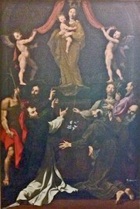
Processional Standard (early 16th century)
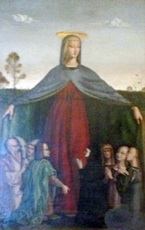

This double-sided standard, which is by an unknown artist and which belonged to the Confraternita della Carità, was first documented during its restoration in 1832. It was moved to the gallery in ca. 1878. Its respective sides depict:
-
✴the Madonna della Misericordia; and
-
✴the crucifixion with the Virgin and St John the Evangelist.
Processional Standard (16th century)
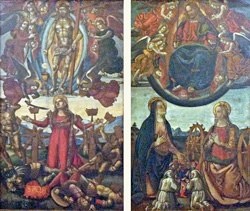
This double-sided standard, which is by an unknown artist, was documented in the sacristy of the Oratorio di Santa Caterina in 1829 and moved to the gallery in ca. 1878:
-
✴one side depicts a scene from the martyrdom of St Catherine of Alexandria, in which the wheel on which she is being tortured shatters as she meditates on an image of the risen Christ; and
-
✴the other side depicts the Virgin and St Catherine interceding with Christ for the people of Città di Castello and, in particular, for members of the confraternity (identified by their white robes).
Virgin and Saints (16th century)
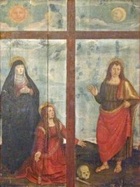
Madonna and Child with Saints (16th century)
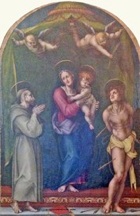
Laying on of hands (16th century)
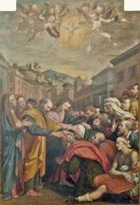
The altarpiece depicts SS Peter and John the Evangelist curing people by the laying on of hands, as the Holy Spirit descends in the form of a dove. The three crosses of the Crucifixion can be seen against the sky to the left, and the miracles are witnessed by the Virgin and two of her ladies (to the left).
Saints (17th century)
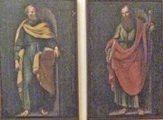
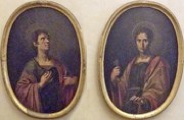
The following four panels, which are of unknown provenance, are attributed to Giovanni Battista Pacetti, lo Sguazzino:
-
✴two rectangular panels depicting SS Peter and Paul; and
-
✴two oval panels depicting unidentified male martyrs.
St Yves among the Poor (ca. 1685)
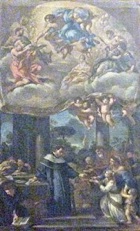
St Peter and the Risen Christ (1718-9)

St Nicholas of Tolentino (1791)
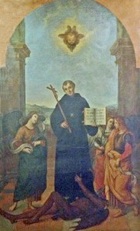
The panel is in fact a loose copy of the lower part of the original. It depicts St Nicholas of Tolentino standing on a dragon, flanked by three standing angels.
Works in Wood
Choir Stalls (early 15th century)
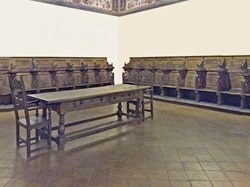

A set of inlaid choir stalls that was in the civic collection by 1897 comprised:
-
✴two groups of nine seats that are now in Room II; and
-
✴two groups of three seats in Room XVII.
They were documented the Monastero di San Benedetto in 1868, and it is likely that this was the original location of most of them. However, it is possible that the group of three illustrated on the left above, which is stylistically distinct from the others, came originally from another location, possibly San Francesco.
Despite heavy restoration, the stalls can be attributed to the workshop of the Florentine Manno di Benincasa Mannucci (Manno dei Cori) on the basis of his signed work of 1435 in San Domenico.
Choir Stalls and Cabinet (1501)

-
✴a central section with five doors and 13 inlaid panels (eleven back panels and two side panels) above; and
-
✴two side benches.
The inscription in the second panel from the right records that Antonio Bencivenni da Mercatello executed the work in 1501 for the prior, Brother Severus of Cesena.
The middle panel is now missing: given that the panels to the sides of it depict instruments of the Passion, it probably contained a scene of the Crucifixion or the Pietà. four coats of arms are depicted, belonging to: Bishop Giulio Vitelli; the Brozzi and Bufalini families; and the Servite Order.
Gilded Wooden Coffin (1558)
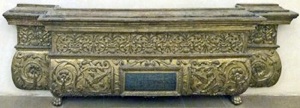
This coffin (in Room XVIII) was commissioned to contain the relics of the Blessed Margherita of Città di Castello in San Domenico after their recognition in 1588. The inscription reads:
DEIPARE VIRGINIS DEVOTISSIMA
VIRGO MARGHERITA TIFHER
PREDICATORUM GLORIA
HIC REQUIESCIT
The relics were removed from the coffin in 1678, when they were placed under the high altar of the church. It was documented in the church in 1728 but moved to the civic collection in ca. 1860.
Read more:
F. F. Mancini (Ed.), “Pinacoteca Comunale Di Città Di Castello”:
Volume 1: “Dipinti”, (1987) Perugia
Volume 2: “Scultura e Arti Decorative”, (1995) Perugia
Return to Museums of Città di Castello.
Return to the Walk I.
